




















Another tick on the bucket list
By Peter Clark
I've been fortunate enough to work in aviation for most of my life, initially in Air Traffic Control at London Heathrow and then as an airline pilot. Commercially I've flown King Airs, Dash 7's, B737's and for the past 23 years I've been flying the Boeing 747-400 for a major U.K. airline.
It was with this background and with my 50th birthday looming, I wondered if it was possible to treat myself and fulfil every pilots dream of flying in a Spitfire.

Over the years I'd chatted to a few lucky pilots in bars who had actually got to "pole" a spit, but despite their rave reviews, I was always slightly worried that if I did get the chance of a flight, it wouldn't quite live up to its legendary status. The thought of disappointment slightly worried me!
The number of two seat spitfires in the U.K. has always been limited, but if it was possible, I really wanted to try and fly in Carolyn Grace's T9 Spitfire ML407 as I had often seen it displayed and knew it's fascinating history. I naively thought 6 months would be adequate time on the "waiting list", but I didn't reckon on the huge demand and in the end I waited almost 6 years and I was 55 when I actually flew in her!

Carolyn's Spitfire ML407/GLFIX was built at Castle Bromwich in 1944 as a MK9 single seat fighter, serving in the last twelve months of WWII, flying a total of 176 operational combat sorties with six different Squadrons.
Flying on D Day over the Normandy beaches she achieved her first kill with Flying Officer Johnnie Houlton DFC at the controls, the first of 6 accredited kills to her name. After the war in 1950-51 she was converted to a two seat aircraft and eventually was sold to the Irish Air Corps. Her last operational flight was in 1960. Effectively moth balled until 1979 she was purchased by Nick Grace and was restored to airworthiness by 1985.
Tragically Nick was killed in a car accident in 1988 but Carolyn decided that she would continue to fly ML407 herself and she displayed her around the U.K. for many years.
After 5 years my flight date approached. The forecast for the week was bad, the only day that it was looking reasonable was my flight day, but it was a marginal forecast with CB's after midday. My morning slot looked lucky. The ML407 is based at ex WW2 airfield Sywell, which was used during the war for pilot training on Tigermoths and later for the repair of Wellington bombers.
Encouragingly, as we arrived ML407 was waiting on the apron for me. Meeting the lovely Carolyn Grace and her team and my pilot Peter Kynsey, who Carolyn had said was one of her most experienced pilots, having flown ML407 for over 25 years.
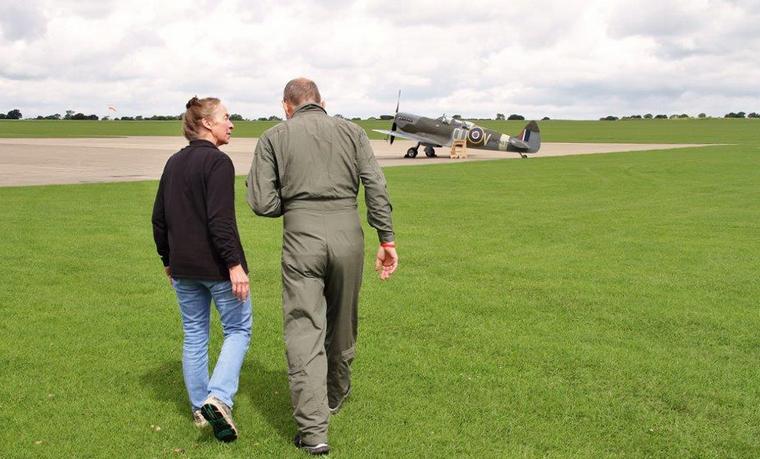
I had the pre-flight briefing and fitting of my flying suit, looking the part we walked to the aircraft I got my first close up look at her. Carolyn had told me that the rear canopy had been designed by her late husband to remain as flush as possible with the fuselage, to try not to ruin the beautiful line of the aircraft.
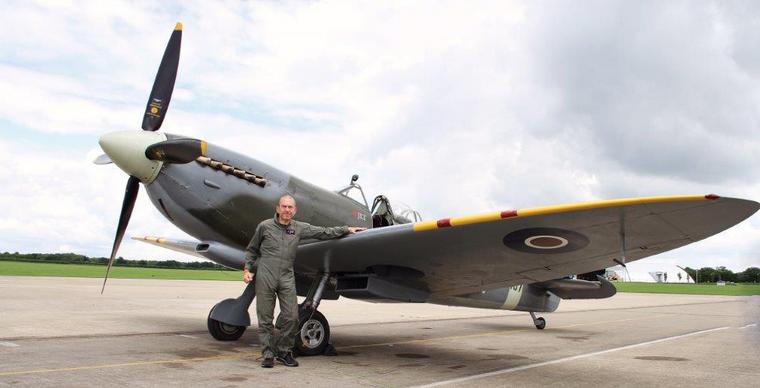
The weather was holding up, with great visibility and some towering Cu, all in all it looked as if we would be fine. Previously I had done some passenger flying in a Tigermoth so had a couple of hundred hours on Tigers and around 500 hours tail wheel, but this was obviously going to be very different.


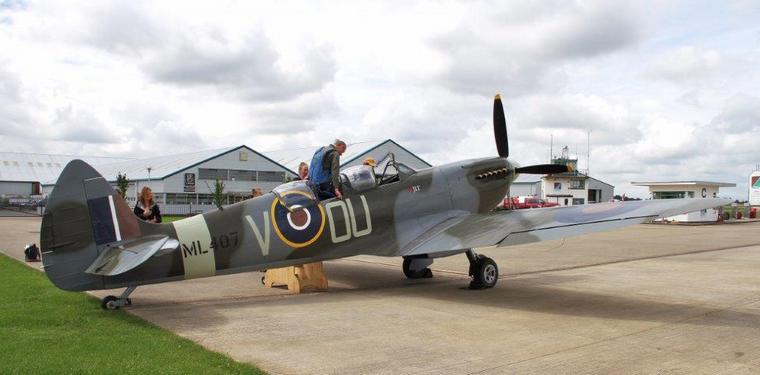

Parachute fitted I climbed in and strapped into the 5-point harness. My first impression was a busy yet strangely familiar cockpit. Just to see the "spade" grip on the control column in front of me was a thrill! How many war films had I seen that featured this famous cockpit!
I had spent some time "mugging up" at home (thanks Youtube!) on the layout of the cockpit and the start procedures. Ergonomically we have come a long way in cockpit design in 80 years... but boy did it smell great!!

The briefing included some tips on handling. Peter said that she was very responsive in roll and if you weren't gentle in pitch (there's no inverted carburettor) a slight push forward on the stick and the engine could cut due fuel starvation. Peter then went through the cockpit instruments and power settings. Boost, which I wasn't familiar with, is used for setting power. For take-off would be +4 to +6, climb +2 to + 4 and cruise at +1/2 to +2. Rpm 2950 for take-off, back to 2650 when airborne, 2400rpm for climb and cruise at 1950-2000 rpm. Luckily Peter would deal with this.
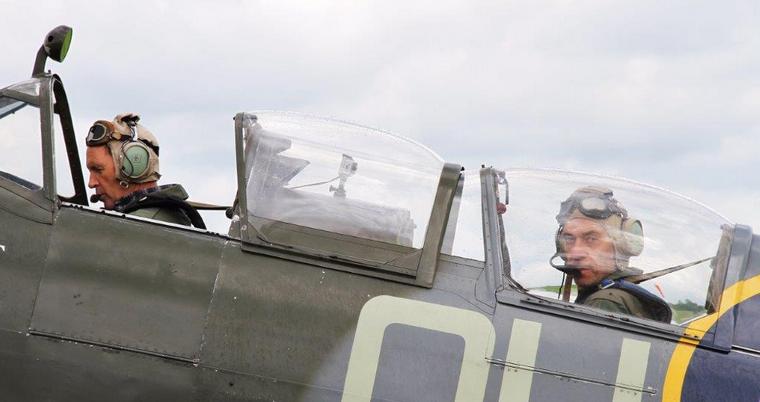
He explained that the main fuel cock was on the right hand side of the cockpit and this needed to be shut after take-off. This required me to perform some light yoga by lifting my right leg off the rudder pedal, straighten it, which would then allow the lever to pass under my leg. This would again be repeated for landing.

Pre start checks complete and the engine primed, the starter was pressed. The prop rotated and after a few turns the engine caught. This was super impressive, as the engine fired, the whole aircraft shook and my view from the cockpit was temporarily obscured by a cloud of blue merlin exhaust smoke.
My flight was the first of the day so a few mins was needed getting the engine warm. As we taxied for runway 21R which would include a back track, which added a few more moments which suited me just fine, a few more minutes of Spitfire time for the log book. The forward visibility pretty much zero as expected, Peter swung the nose from side to side to follow the taxiway.
Engine run ups complete we back-tracked the hard runway and lined up for take -off.
Peter opened the throttles slowly and then the applied full power, countering the left swing as he did this, in a few seconds we were airborne. 180 mph (155 knots) was the climb out speed. The airspeed inductor was readable at lower speeds but I found it more tricky to understand at higher values.. far too many years using the speed tape on the 747! At around 500 feet, Peter said "You have control"! This was perfect. I managed to pick my way around the Cu as we headed away from the airfield. There was no disappointment here!
My Initial impressions of handling was as Peter had said, she was super responsive in roll and I was careful to be gentle in pitch. Finally, every school boys (and girls) dream of getting your hands of a spit. I levelled at around 3000 feet Peter let me handle her for about 10 minutes dodging the Cu and towering Cu before asking me if I wanted to do anything? I'm not a super fan of aerobatics but I would have never forgiven myself if I hadn't done at least something in a Spitfire.
"Any chance of a victory roll?" I asked? The Enigmatic victory roll it was to be! We climbed higher and Peter did his checks and clearing turns and the aircraft descended slightly and then we pulled up and rotated through and into a perfect aileron roll.
At that moment, it was taken back to the scene in the Battle of Britain film when a young pilot flies across the airfield after a successful attack on a group of Heinkel 111 and performs a victory roll over the airfield. I could hear Christopher Plummer's character saying to this unfortunate pilot, "If the controls had been damaged he would've been spread over the airfield like "strawberry jam." Next a loop. 300 mph (260 knots) dive and up and around we went. Just perfect.

Time for the return to the airfield and the classic "run and break". Peter took control as we neared the pattern, accelerating as we flew towards the runway. Now this was fun... Flying down the runway we pulled up and round into a tight right hand downwind. I did my yoga bit in the back as we switched the fuel cock back on to the main tank.
As we called downwind Peter did the landing checks. Selecting the gear down I got that familiar pilot " aghh ". The sound we make when something happens that we aren't expecting!
After a reasonable amount of time, I gently enquired as to our "status" and Peter said "the gear hasn't come down!" Okay! If I'm honest my thoughts were quite positive at this point, it was either going to be a wheels up landing in a Spitfire which (having survived!) I would dine out on for the rest of my life or we fix it but I'll get more time airborne. It was win win as far as I was concerned...
Anyway, Peter called the tower and asked if we could clear the circuit as we had a problem. I was now asked if I could lower my seat, as the plan was to push the stick hard forward and then pull back and select the gear down. The G would extend the gear. This sounded like a plan. Peter asked if I was ready and pushed the stick hard forward, the merlin cut out and as he pulled back hard, it coughed and about 10 feet of black smoke engulfed us. From the ground my slightly concerned family looked on, as they heard the engine cut and then recover after a few pops and bangs and clouds of black smoke trailing behind us.
The green gear light indicated that the gear was down and we re-joined the circuit on a right base. Flap selected (full flap only on the 'Spit' and a draggy 85 degs too!) and we were clear to land. Approach speed is around 135-145 mph (117-126 knots) and over the hedge glide speed of 115-120 mph (100-104 knots). The aircraft settled nicely on to the runway. Peter kept her straight as we rolled down to taxi speed.
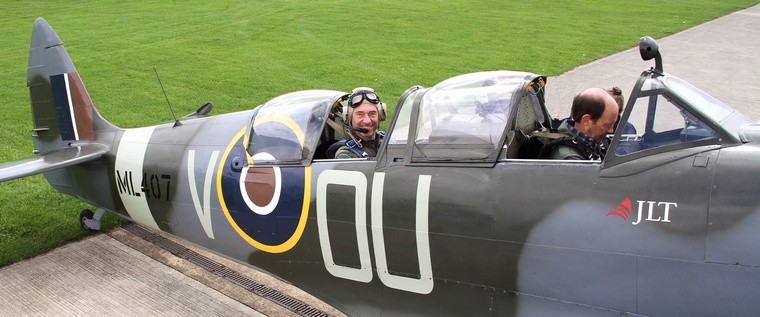
There it was. Finally, I'd flown in a Supermarine Spitfire. The iconic aircraft that had helped the RAF win the Battle of Britain and stopped the German invasion of the U.K. It was everything I'd hoped for, beautiful to handle and just a ream to fly. If you ever get the chance, don't worry, you won't be disappointed!
Subs notes:-
Peter first soloed aged 16 January 1978 in a Slingsby T31 Mk3 with the U.K. Air Cadets. The aircraft is now housed in the Southampton Air Museum. From there he qualified as an ATC at Heathrow and obtained his PPL in 1981 in Dallas, Texas.
By 1986, he'd obtained his Com licence (frozen ATPL) and soon moved onto heavy metal in the form of King Air B200,F90 and B300. Dash 7s were next on the licence, flying out from London City on its opening, 26 October 1987. A brief stint on 737-200 and 400 followed in 1989-92 before he joined the Jumbo (747-400) which he flies to this day.
Peter has some 21 500 hours in his licence, with some 15 000 on 747s. His current aircraft, an Bölkow Bo 209 Monsun, enjoys a few hours a year when he's not horse riding under our sunny skies near Vaalwater.
Besides the Spitfire nostalgia, he also flew Tigermoth GANMV/T7404 commercially for pleasure flights between 1989 and 1998 which no doubt added a few hours to the 21000.
It was with this background and with my 50th birthday looming, I wondered if it was possible to treat myself and fulfil every pilots dream of flying in a Spitfire.

Over the years I'd chatted to a few lucky pilots in bars who had actually got to "pole" a spit, but despite their rave reviews, I was always slightly worried that if I did get the chance of a flight, it wouldn't quite live up to its legendary status. The thought of disappointment slightly worried me!
The number of two seat spitfires in the U.K. has always been limited, but if it was possible, I really wanted to try and fly in Carolyn Grace's T9 Spitfire ML407 as I had often seen it displayed and knew it's fascinating history. I naively thought 6 months would be adequate time on the "waiting list", but I didn't reckon on the huge demand and in the end I waited almost 6 years and I was 55 when I actually flew in her!

Carolyn's Spitfire ML407/GLFIX was built at Castle Bromwich in 1944 as a MK9 single seat fighter, serving in the last twelve months of WWII, flying a total of 176 operational combat sorties with six different Squadrons.
Flying on D Day over the Normandy beaches she achieved her first kill with Flying Officer Johnnie Houlton DFC at the controls, the first of 6 accredited kills to her name. After the war in 1950-51 she was converted to a two seat aircraft and eventually was sold to the Irish Air Corps. Her last operational flight was in 1960. Effectively moth balled until 1979 she was purchased by Nick Grace and was restored to airworthiness by 1985.
Tragically Nick was killed in a car accident in 1988 but Carolyn decided that she would continue to fly ML407 herself and she displayed her around the U.K. for many years.
After 5 years my flight date approached. The forecast for the week was bad, the only day that it was looking reasonable was my flight day, but it was a marginal forecast with CB's after midday. My morning slot looked lucky. The ML407 is based at ex WW2 airfield Sywell, which was used during the war for pilot training on Tigermoths and later for the repair of Wellington bombers.
Encouragingly, as we arrived ML407 was waiting on the apron for me. Meeting the lovely Carolyn Grace and her team and my pilot Peter Kynsey, who Carolyn had said was one of her most experienced pilots, having flown ML407 for over 25 years.

I had the pre-flight briefing and fitting of my flying suit, looking the part we walked to the aircraft I got my first close up look at her. Carolyn had told me that the rear canopy had been designed by her late husband to remain as flush as possible with the fuselage, to try not to ruin the beautiful line of the aircraft.

The weather was holding up, with great visibility and some towering Cu, all in all it looked as if we would be fine. Previously I had done some passenger flying in a Tigermoth so had a couple of hundred hours on Tigers and around 500 hours tail wheel, but this was obviously going to be very different.




Parachute fitted I climbed in and strapped into the 5-point harness. My first impression was a busy yet strangely familiar cockpit. Just to see the "spade" grip on the control column in front of me was a thrill! How many war films had I seen that featured this famous cockpit!
I had spent some time "mugging up" at home (thanks Youtube!) on the layout of the cockpit and the start procedures. Ergonomically we have come a long way in cockpit design in 80 years... but boy did it smell great!!


He explained that the main fuel cock was on the right hand side of the cockpit and this needed to be shut after take-off. This required me to perform some light yoga by lifting my right leg off the rudder pedal, straighten it, which would then allow the lever to pass under my leg. This would again be repeated for landing.

Pre start checks complete and the engine primed, the starter was pressed. The prop rotated and after a few turns the engine caught. This was super impressive, as the engine fired, the whole aircraft shook and my view from the cockpit was temporarily obscured by a cloud of blue merlin exhaust smoke.
My flight was the first of the day so a few mins was needed getting the engine warm. As we taxied for runway 21R which would include a back track, which added a few more moments which suited me just fine, a few more minutes of Spitfire time for the log book. The forward visibility pretty much zero as expected, Peter swung the nose from side to side to follow the taxiway.
Engine run ups complete we back-tracked the hard runway and lined up for take -off.
Peter opened the throttles slowly and then the applied full power, countering the left swing as he did this, in a few seconds we were airborne. 180 mph (155 knots) was the climb out speed. The airspeed inductor was readable at lower speeds but I found it more tricky to understand at higher values.. far too many years using the speed tape on the 747! At around 500 feet, Peter said "You have control"! This was perfect. I managed to pick my way around the Cu as we headed away from the airfield. There was no disappointment here!
My Initial impressions of handling was as Peter had said, she was super responsive in roll and I was careful to be gentle in pitch. Finally, every school boys (and girls) dream of getting your hands of a spit. I levelled at around 3000 feet Peter let me handle her for about 10 minutes dodging the Cu and towering Cu before asking me if I wanted to do anything? I'm not a super fan of aerobatics but I would have never forgiven myself if I hadn't done at least something in a Spitfire.
"Any chance of a victory roll?" I asked? The Enigmatic victory roll it was to be! We climbed higher and Peter did his checks and clearing turns and the aircraft descended slightly and then we pulled up and rotated through and into a perfect aileron roll.
At that moment, it was taken back to the scene in the Battle of Britain film when a young pilot flies across the airfield after a successful attack on a group of Heinkel 111 and performs a victory roll over the airfield. I could hear Christopher Plummer's character saying to this unfortunate pilot, "If the controls had been damaged he would've been spread over the airfield like "strawberry jam." Next a loop. 300 mph (260 knots) dive and up and around we went. Just perfect.

Time for the return to the airfield and the classic "run and break". Peter took control as we neared the pattern, accelerating as we flew towards the runway. Now this was fun... Flying down the runway we pulled up and round into a tight right hand downwind. I did my yoga bit in the back as we switched the fuel cock back on to the main tank.
As we called downwind Peter did the landing checks. Selecting the gear down I got that familiar pilot " aghh ". The sound we make when something happens that we aren't expecting!
After a reasonable amount of time, I gently enquired as to our "status" and Peter said "the gear hasn't come down!" Okay! If I'm honest my thoughts were quite positive at this point, it was either going to be a wheels up landing in a Spitfire which (having survived!) I would dine out on for the rest of my life or we fix it but I'll get more time airborne. It was win win as far as I was concerned...
Anyway, Peter called the tower and asked if we could clear the circuit as we had a problem. I was now asked if I could lower my seat, as the plan was to push the stick hard forward and then pull back and select the gear down. The G would extend the gear. This sounded like a plan. Peter asked if I was ready and pushed the stick hard forward, the merlin cut out and as he pulled back hard, it coughed and about 10 feet of black smoke engulfed us. From the ground my slightly concerned family looked on, as they heard the engine cut and then recover after a few pops and bangs and clouds of black smoke trailing behind us.
The green gear light indicated that the gear was down and we re-joined the circuit on a right base. Flap selected (full flap only on the 'Spit' and a draggy 85 degs too!) and we were clear to land. Approach speed is around 135-145 mph (117-126 knots) and over the hedge glide speed of 115-120 mph (100-104 knots). The aircraft settled nicely on to the runway. Peter kept her straight as we rolled down to taxi speed.

There it was. Finally, I'd flown in a Supermarine Spitfire. The iconic aircraft that had helped the RAF win the Battle of Britain and stopped the German invasion of the U.K. It was everything I'd hoped for, beautiful to handle and just a ream to fly. If you ever get the chance, don't worry, you won't be disappointed!
Subs notes:-
Peter first soloed aged 16 January 1978 in a Slingsby T31 Mk3 with the U.K. Air Cadets. The aircraft is now housed in the Southampton Air Museum. From there he qualified as an ATC at Heathrow and obtained his PPL in 1981 in Dallas, Texas.
By 1986, he'd obtained his Com licence (frozen ATPL) and soon moved onto heavy metal in the form of King Air B200,F90 and B300. Dash 7s were next on the licence, flying out from London City on its opening, 26 October 1987. A brief stint on 737-200 and 400 followed in 1989-92 before he joined the Jumbo (747-400) which he flies to this day.
Peter has some 21 500 hours in his licence, with some 15 000 on 747s. His current aircraft, an Bölkow Bo 209 Monsun, enjoys a few hours a year when he's not horse riding under our sunny skies near Vaalwater.
Besides the Spitfire nostalgia, he also flew Tigermoth GANMV/T7404 commercially for pleasure flights between 1989 and 1998 which no doubt added a few hours to the 21000.
 |
 |
 Copyright © 2024 Pilot's Post PTY Ltd
The information, views and opinions by the authors contributing to Pilot’s Post are not necessarily those of the editor or other writers at Pilot’s Post.
Copyright © 2024 Pilot's Post PTY Ltd
The information, views and opinions by the authors contributing to Pilot’s Post are not necessarily those of the editor or other writers at Pilot’s Post.